Membrane Fouling Control and Treatment Performance Using Coagulation–Tubular Ceramic Membrane with Concentrate Recycling
Abstract
1. Introduction
2. Materials and Methods
2.1. Tubular Ceramic Membrane
2.2. Experimental Setups
- Process 1: Direct filtration–tubular ceramic membrane (DF-TCM).
- Raw water was directly subjected to constant-flux dead-end filtration through TCM without pretreatment.
- Process 2: Coagulation–tubular ceramic membrane (C-TCM).
- The raw water was first mixed with polyaluminum chloride (PACl) at a dose of 1.5 mg-Al/L in a rapid mixing tank (200 rpm, 1 min), followed by flocculation in a flocculator (80 rpm, 10 min), and finally treated by constant-flux dead-end membrane filtration.
- Process 3: Coagulation–tubular ceramic membrane with concentrate recycling (C-TCM-CR).
- Based on Process 2, this modified process implemented cross-flow filtration for the TCM, operating with the cross-flow stream equivalent to 3% of the total influent flow, while ensuring complete recycling of all generated concentrate back to the flocculator.
- All three treatment processes employed identical TCM operating parameters, maintaining a constant flux of 75 L/(m2·h) during the 1 h filtration cycles. Each cycle concluded with an automated hydraulic backwash at 120 L/(m2·h) for 1 min duration to ensure optimal membrane performance.
- After every 8 filtration cycles, comprehensive chemical cleaning was conducted: Alkaline cleaning: 1000 mg/L NaClO + 1000 mg/L NaOH, injected for 1 min, circulated for 2 h; acid cleaning: 2% citric acid, injected for 1 min, circulated for 2 h.
2.3. Raw Water
2.4. Analytical Methods
3. Results
3.1. Primary Characteristics of TCM Fouling
3.1.1. Evolution of TMP in TCM
3.1.2. Floc Size Distribution Characteristics
3.1.3. Microstructural Characterization of Cake Layers
3.2. Contaminant-Specific Removal Performance
3.2.1. CODMn
3.2.2. UV254
3.2.3. Turbidity
3.2.4. Fluorescent Compounds
3.2.5. Organic Compounds with Different Molecular Weights
4. Conclusions
Author Contributions
Funding
Institutional Review Board Statement
Informed Consent Statement
Data Availability Statement
Conflicts of Interest
References
- Malkoske, T.A.; Bérubé, P.R.; Andrews, R.C. Coagulation/flocculation prior to low pressure membranes in drinking water treatment: A review. Environ. Sci. Water Res. Technol. 2020, 6, 2993–3023. [Google Scholar] [CrossRef]
- Wang, Y.; Ma, B.; Ulbricht, M.; Dong, Y.; Zhao, X. Progress in alumina ceramic membranes for water purification: Status and prospects. Water Res. 2022, 226, 119173. [Google Scholar] [CrossRef]
- Kurth, C.J.; Wise, B.L.; Smith, S. Design considerations for implementing ceramics in new and existing polymeric UF systems. Water Pract. Technol. 2018, 13, 725–737. [Google Scholar] [CrossRef]
- Jarvis, P.; Carra, I.; Jafari, M.; Judd, S. Ceramic vs. polymeric membrane implementation for potable water treatment. Water Res. 2022, 215, 118269. [Google Scholar] [CrossRef]
- Sánchez-Arévalo, C.M.; Vincent-Vela, M.C.; Luján-Facundo, M.J.; Alvarez-Blanco, S. Ultrafiltration with organic solvents: A review on achieved results, membrane materials and challenges to face. Process Saf. Environ. Prot. 2023, 177, 118–137. [Google Scholar] [CrossRef]
- Asif, M.B.; Zhang, Z. Ceramic membrane technology for water and wastewater treatment: A critical review of performance, full-scale applications, membrane fouling and prospects. Chem. Eng. J. 2021, 418, 129481. [Google Scholar] [CrossRef]
- Xie, Y.; Fan, C.; Fang, Y.; Zhu, X.; Yan, J.; Liu, H.; Liu, H. Ceramic ultrafiltration membrane as pretreatment for drinking water nanofiltration treatment: Performance, cleaning, and costs based on an engineering case. J. Clean. Prod. 2025, 506, 145527. [Google Scholar] [CrossRef]
- Dong, Y.; Wu, H.; Yang, F.; Gray, S. Cost and efficiency perspectives of ceramic membranes for water treatment. Water Res. 2022, 220, 118629. [Google Scholar] [CrossRef]
- Niu, C.; Li, X.; Dai, R.; Wang, Z. Artificial intelligence-incorporated membrane fouling prediction for membrane-based processes in the past 20 years: A critical review. Water Res. 2022, 216, 118299. [Google Scholar] [CrossRef]
- Luo, H.; Wang, Z. A new ultrasonic cleaning model for predicting the flux recovery of the UF membrane fouled with humic acid. J. Environ. Chem. Eng. 2022, 10, 107156. [Google Scholar] [CrossRef]
- Xiao, T.; Zhu, Z.; Li, L.; Shi, J.; Li, Z.; Zuo, X. Membrane fouling and cleaning strategies in microfiltration/ultrafiltration and dynamic membrane. Sep. Purif. Technol. 2023, 318, 123977. [Google Scholar] [CrossRef]
- Wang, Y.; Li, M.; Yang, H. A review on mitigation of pressure-driven membrane fouling by coagulation/flocculation as a pretreatment in membrane separation processes. Sep. Purif. Technol. 2025, 36, 132370. [Google Scholar] [CrossRef]
- Huang, H.; Schwab, K.; Jacangelo, J.G. Pretreatment for low pressure membranes in water treatment: A review. Environ. Sci. Technol. 2009, 43, 3011–3019. [Google Scholar] [CrossRef]
- Gao, W.; Liang, H.; Ma, J.; Han, M.; Chen, Z.; Han, Z.; Li, G. Membrane fouling control in ultrafiltration technology for drinking water production: A review. Desalination 2011, 272, 1–8. [Google Scholar] [CrossRef]
- Wei, H.; Gao, B.; Ren, J.; Li, A.; Yang, H. Coagulation/flocculation in dewatering of sludge: A review. Water Res. 2018, 143, 608–631. [Google Scholar] [CrossRef]
- Xu, M.; Wang, X.; Zhou, B.; Zhou, L. Pre-coagulation with cationic flocculant-composited titanium xerogel coagulant for alleviating subsequent ultrafiltration membrane fouling by algae-related pollutants. J. Hazard. Mater. 2021, 407, 124838. [Google Scholar] [CrossRef]
- Li, L.; Chen, X.; Shao, S.; Zhang, X.; Zhang, H. Study on the mechanism of hydrodynamic manipulation of floc structure to achieve high-flux of coagulation macro-filtration for the rapid removal of Aphanizomenon flos-aquae. J. Clean. Prod. 2024, 434, 140397. [Google Scholar] [CrossRef]
- He, H.; Liu, Y.; Wang, L.; Qiu, W.; Li, D.; Liu, Z.; Ma, J. Improvements of ferrate (VI) pretreatment on membrane flux and membrane rejection using cheap NaClO reagent. Water Res. 2023, 229, 119520. [Google Scholar] [CrossRef]
- Dotto, J.; Fagundes-Klen, M.R.; Veit, M.T.; Palacio, S.; Bergamasco, R. Performance of different coagulants in the coagulation/flocculation process of textile wastewater. J. Clean. Prod. 2019, 208, 656–665. [Google Scholar] [CrossRef]
- Srivastava, S.; Das, C. Advanced hybridization of coagulation–ultrafiltration systems: A critical techno-economic review of integration strategies. J. Water Process Eng. 2024, 68, 106297. [Google Scholar] [CrossRef]
- Wei, Y.; Yao, W.; Gui, B.; Dong, B. Treatment of Taihu Lake Water by On-line Coagulation/Ultrafiltration. China Water Wastewater 2019, 35, 54–58. [Google Scholar] [CrossRef]
- Zhao, Y.; Liang, X.; Huang, Y.; Xia, S. Study on treatment of Yangtze River raw water using online coagulation-plate ceramic membrane filtration process. Ind. Water Wastewater 2020, 51, 11–16. [Google Scholar] [CrossRef]
- Liu, Y.; Wang, Z.; Xu, M.; Qi, F.; Li, C.; Sun, D.; Nan, J.; Li, W.; Guan, X.; Ikhlaq, A. Unveiling the role of cake layer in coagulation-ultrafiltration on membrane fouling and emerging application as dynamic membrane before ultrafiltration. Sep. Purif. Technol. 2024, 350, 127932. [Google Scholar] [CrossRef]
- Wang, W.; Yue, Q.; Guo, K.; Bu, F.; Shen, X.; Gao, B. Application of Al species in coagulation/ultrafiltration process: Influence of cake layer on membrane fouling. J. Membr. Sci. 2019, 572, 161–170. [Google Scholar] [CrossRef]
- Kitchener, B.G.B.; Wainwright, J.; Parsons, A.J. A review of the principles of turbidity measurement. Prog. Phys. Geogr. 2017, 41, 620–642. [Google Scholar] [CrossRef]
- Laszakovits, J.R.; Somogyi, A.; MacKay, A.A. Chemical alterations of dissolved organic matter by permanganate oxidation. Environ. Sci. Technol. 2020, 54, 3256–3266. [Google Scholar] [CrossRef]
- Pang, Z.; Cai, Y.; Xiong, W.; Xiao, J.; Zou, j. A spectrophotometric method for measuring permanganate index (CODMn) by N, N-diethyl-p-phenylenediamine (DPD). Chemosphere 2021, 266, 128936. [Google Scholar] [CrossRef]
- Shi, Z.; Chow, C.W.K.; Fabris, R.; Zheng, T.; Liu, J.; Jin, B. Evaluation of the impact of suspended particles on the UV absorbance at 254 nm (UV 254) measurements using a submersible UV-Vis spectrophotometer. Environ. Sci. Pollut. Res. 2021, 28, 12576–12586. [Google Scholar] [CrossRef]
- Fan, C.; Yan, J.; Liu, H.; Xie, Y.; Liu, H. Performance and membrane fouling characteristics of a drinking water multistage NF system based on membrane autopsy from a full-scale system. J. Water Process Eng. 2024, 58, 104909. [Google Scholar] [CrossRef]
- Tang, X.; Guo, T.; Chang, H.; Yue, X.; Wang, J.; Yu, H.; Xie, B.; Zhu, X.; Li, G.; Liang, H. Membrane fouling alleviation by chemically enhanced backwashing in treating algae-containing surface water: From bench-scale to full-scale application. Engineering 2022, 19, 40–49. [Google Scholar] [CrossRef]
- Xu, M.; Ju, W.; Wang, Z.; Nan, J.; Qi, F.; Li, C.; Liu, Y.; Li, W.; Sun, D. New insights into membrane fouling in coagulation-ultrafiltration by cake characteristics analysis: A case study with PACl-Al13 and PACl. J. Environ. Sci. 2024, 146, 217–225. [Google Scholar] [CrossRef]
- Shi, J.; Wang, J.; Yang, S.; Li, S.; Liu, j. Membrane fouling and influencing factors of a submerged commercial ceramic flat membrane bioreactor in treatment of coal chemical wastewater. J. Environ. Chem. Eng. 2023, 11, 111510. [Google Scholar] [CrossRef]
- Feng, L.; Zhao, S.; Sun, S.; Wang, W.; Gao, B.; Yue, Q. Effect of pH with different purified aluminum species on coagulation performance and membrane fouling in coagulation/ultrafiltration process. J. Hazard. Mater. 2015, 300, 67–74. [Google Scholar] [CrossRef]
- Ma, C.; Zhang, Z.; Xu, L.; Rashid, S.; Li, G.; Graham, N.; Yu, W. Overlooked Influence of Phosphate on the Performance of a Dual Membrane Process with Coagulation Pretreatment. Water Res. 2025, 285, 124082. [Google Scholar] [CrossRef]
- Yan, M.; Shen, X.; Gao, B.; Guo, K.; Yue, Q. Coagulation-ultrafiltration integrated process for membrane fouling control: Influence of Al species and SUVA values of water. Sci. Total Environ. 2021, 793, 148517. [Google Scholar] [CrossRef]
- Wu, S.; Ma, B.; Hu, C.; Hua, X.; Fan, H.; Ulbricht, M.; Qu, J. Cake layer 3D structure regulation to optimize water channels during Al-based coagulation-ultrafiltration process. Water Res. 2023, 236, 119941. [Google Scholar] [CrossRef]
- Wang, W.; Yang, M.; Ma, H.; Liu, Z.; Gai, L.; Zheng, Z.; Ma, H. Removal behaviors and mechanism of polystyrene microplastics by coagulation/ultrafiltration process: Co-effects of humic acid. Sci. Total Environ. 2023, 881, 163408. [Google Scholar] [CrossRef]
- Altmann, J.; Massa, L.; Sperlich, A.; Gnirss, R.; Jekel, M. UV254 absorbance as real-time monitoring and control parameter for micropollutant removal in advanced wastewater treatment with powdered activated carbon. Water Res. 2016, 94, 240–245. [Google Scholar] [CrossRef]
- Liu, Z.; Li, H.; Xiong, X.; Wang, Q.; Yan, Y.; Tu, J.; Cui, Y.; Li, X.; Wen, G.; Wu, X. Potential of the integration of coagulation and ozonation as a pretreatment of reverse osmosis concentrate from coal gasification wastewater reclamation. Chemosphere 2019, 222, 696–704. [Google Scholar] [CrossRef]
- Wang, H.; Ding, A.; Gan, Z.; Qu, F.; Cheng, X.; Bai, L.; Guo, S.; Li, G.; Liang, H. Fluorescent natural organic matter responsible for ultrafiltration membrane fouling: Fate, contributions and fouling mechanisms. Chemosphere 2017, 182, 183–193. [Google Scholar] [CrossRef]
- Zhang, R.; Fan, Z.; Han, Z.; Yan, H.; Song, j.; Tian, J. Combined Process of Micro-flocculation + Hollow Flat-sheet Ceramic Membrane for Treatment of Micro-polluted Surface Water. China Water Wastewater 2023, 39, 23–29. [Google Scholar] [CrossRef]
- Zhou, Z.; Liu, C.; Tian, L.; Wang, H.; Yang, Y.; Wang, X.; Cheng, X. Moderate pre-photocatalysis-enhanced coagulation alleviates ultrafiltration membrane fouling of algae-laden water. J. Water Process Eng. 2023, 56, 104406. [Google Scholar] [CrossRef]
- Zhang, Y.; Teng, J.; Zou, H.; Zhang, W.; Cheng, S.; Zhang, M.; Lin, H. The molecular weight-fouling matrix: A novel dissection of polysaccharide interactions in ultrafiltration processes. Sep. Purif. Technol. 2024, 345, 127340. [Google Scholar] [CrossRef]
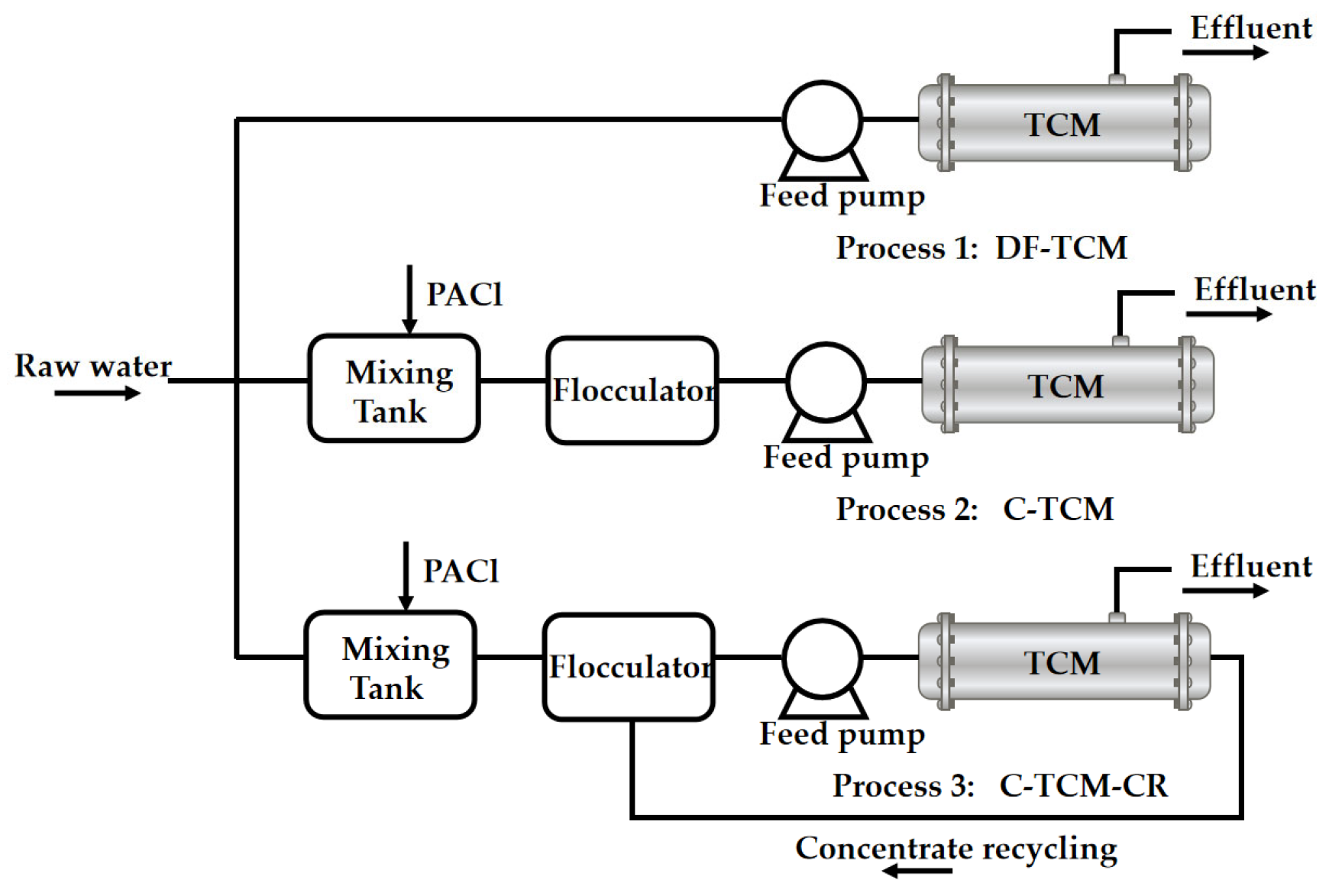
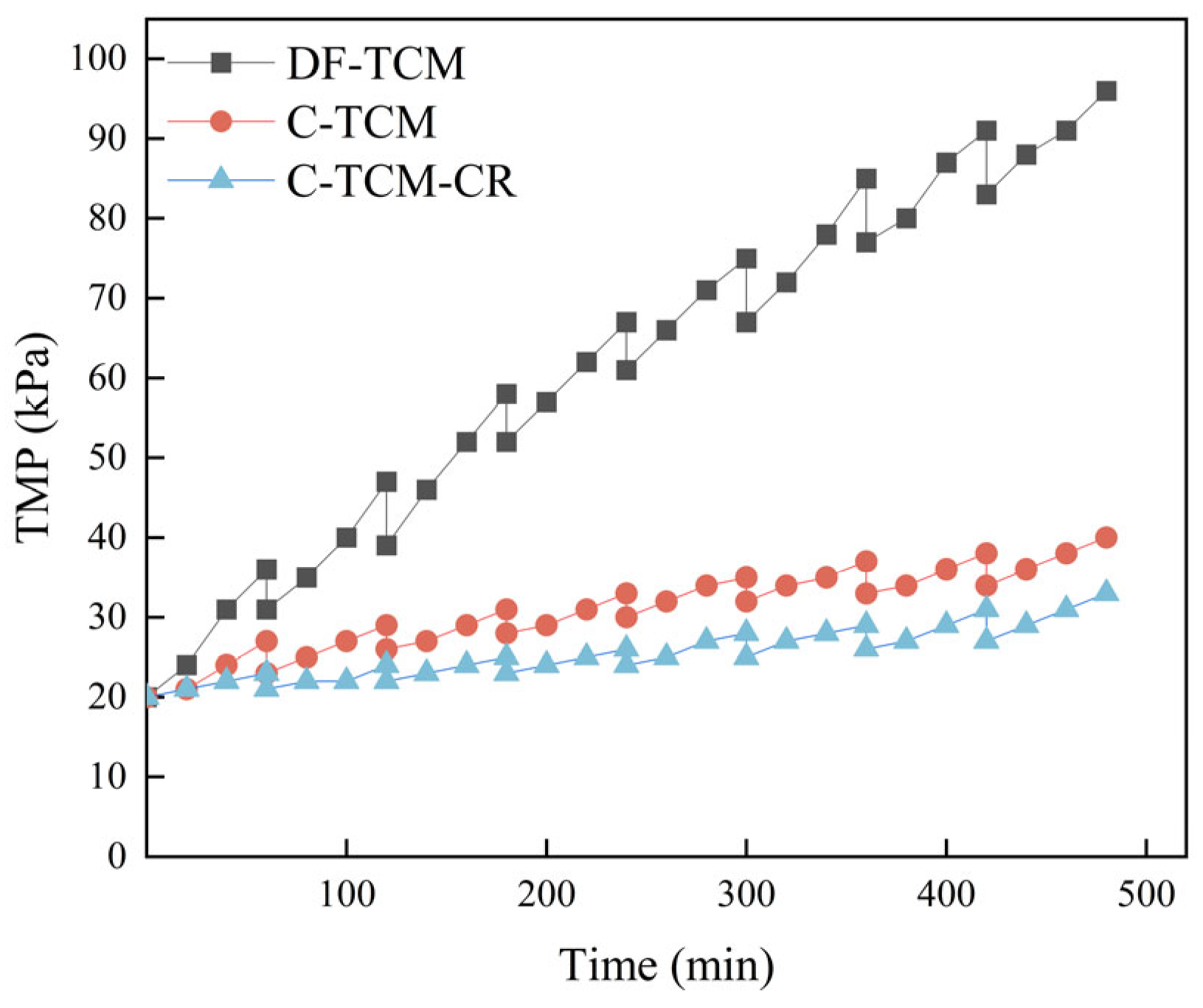
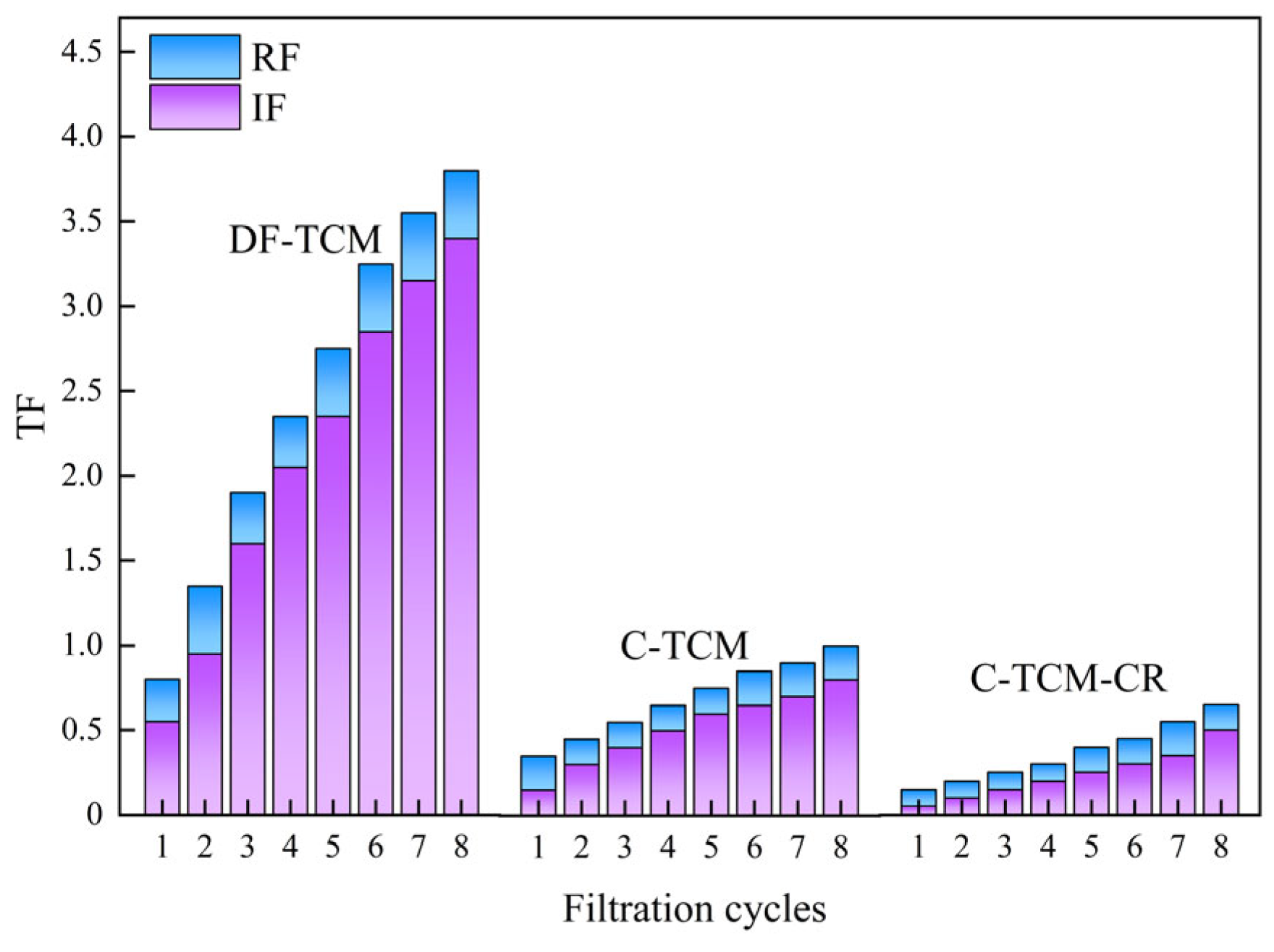


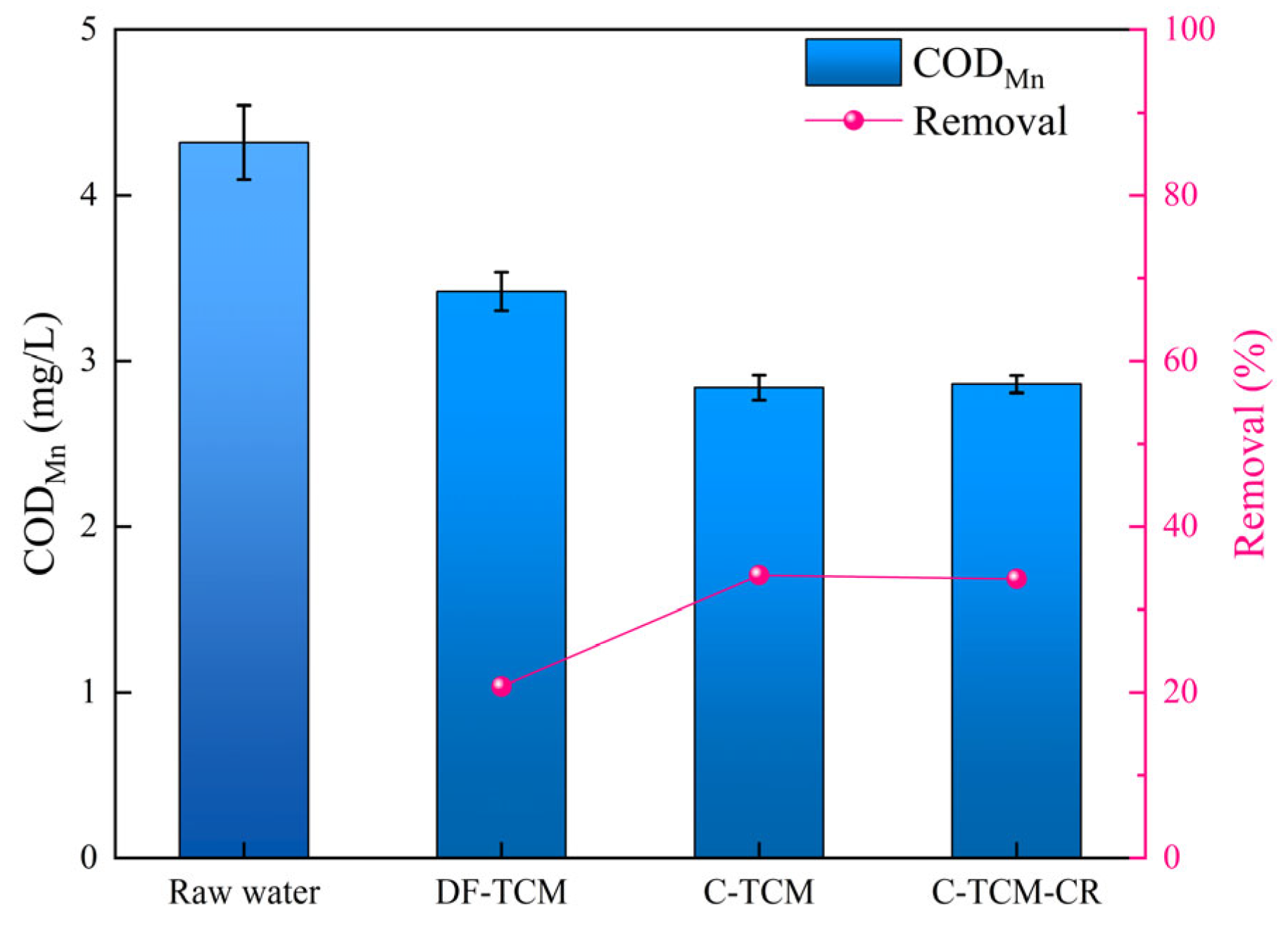

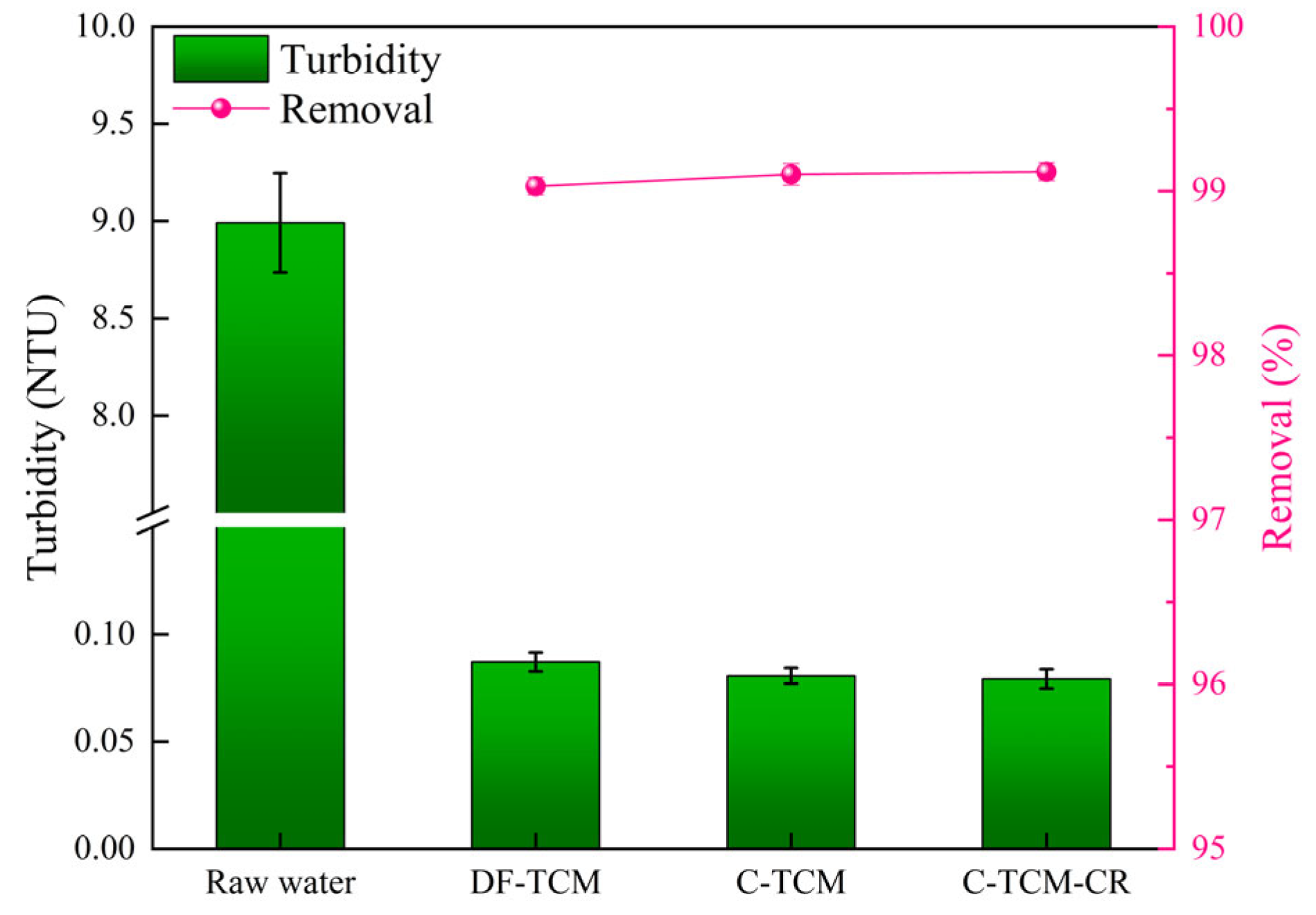



| Parameters | Specification |
|---|---|
| Material | α-Al2O3 |
| Pore size, nm | 30 |
| Molecular weight cut-off, Da | 100,000 |
| Operating TMP, kPa | <100 |
| Operational temperature, °C | −20–60 |
| Parameters | Value |
|---|---|
| Temperature, °C | 26.30–27.20 |
| Turbidity, NTU | 8.50–9.28 |
| pH | 7.47–7.88 |
| CODMn, mg/L | 4.12–4.56 |
| UV254, cm−1 | 0.071–0.076 |
| Ammonia, mg/L | 0.07–0.10 |
| Fe, mg/L | 0.035–0.039 |
| Mn, mg/L | 0.011–0.012 |
| , mg/L | 55.73–60.10 |
| -N | <0.02 |
| Electrical conductivity, μS/cm | 378–420 |
| Total alkalinity, mg/L | 125.3–138.8 |
| Total hardness, mg/L | 118.1–134.7 |
Disclaimer/Publisher’s Note: The statements, opinions and data contained in all publications are solely those of the individual author(s) and contributor(s) and not of MDPI and/or the editor(s). MDPI and/or the editor(s) disclaim responsibility for any injury to people or property resulting from any ideas, methods, instructions or products referred to in the content. |
© 2025 by the authors. Licensee MDPI, Basel, Switzerland. This article is an open access article distributed under the terms and conditions of the Creative Commons Attribution (CC BY) license (https://creativecommons.org/licenses/by/4.0/).
Share and Cite
Xie, Y.; Fang, Y.; Chen, D.; Wei, J.; Fan, C.; Zhu, X.; Liu, H. Membrane Fouling Control and Treatment Performance Using Coagulation–Tubular Ceramic Membrane with Concentrate Recycling. Membranes 2025, 15, 225. https://doi.org/10.3390/membranes15080225
Xie Y, Fang Y, Chen D, Wei J, Fan C, Zhu X, Liu H. Membrane Fouling Control and Treatment Performance Using Coagulation–Tubular Ceramic Membrane with Concentrate Recycling. Membranes. 2025; 15(8):225. https://doi.org/10.3390/membranes15080225
Chicago/Turabian StyleXie, Yawei, Yichen Fang, Dashan Chen, Jiahang Wei, Chengyue Fan, Xiwang Zhu, and Hongyuan Liu. 2025. "Membrane Fouling Control and Treatment Performance Using Coagulation–Tubular Ceramic Membrane with Concentrate Recycling" Membranes 15, no. 8: 225. https://doi.org/10.3390/membranes15080225
APA StyleXie, Y., Fang, Y., Chen, D., Wei, J., Fan, C., Zhu, X., & Liu, H. (2025). Membrane Fouling Control and Treatment Performance Using Coagulation–Tubular Ceramic Membrane with Concentrate Recycling. Membranes, 15(8), 225. https://doi.org/10.3390/membranes15080225






